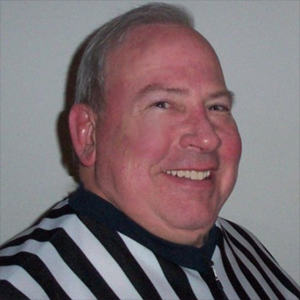
Rndballref
20 Years Experience
Chicago, IL
Male, 60
For twenty years I officiated high school, AAU and park district basketball games, retiring recently. For a few officiating is the focus of their occupation, while for most working as an umpire or basketball referee is an avocation. I started ref'ing to earn beer money during college, but it became a great way to stay connected to the best sports game in the universe. As a spinoff, I wrote a sports-thriller novel loosely based on my referee experiences titled, Advantage Disadvantage
ok
The defender must legally obtain the vertical space BEFORE the offensive player alights for a shot. So, if player B legally obtains a place on the floor and Player A crashes into him while coming down from a shot, player control foul on A.
The defensive player can be moving, but the rulebook says he must be moving obliquely, which means the defender cannot move directly into the path of the offensive player. For example a player who is backpedaling and is run over by the offensive player would draw a player control foul on the dribbler. You can also move sideways and backwards as a defender and still draw a charge.
A free thrower is not obligated to make the free throw. He must hit the ring and not violate other free throw provisions (entering the lane early, etc.). Most players in that situation should throw a flat shot towards the ring, barely ever going above the rim.
Yes, because the line is out of bounds.
Hospice Nurse
 Do most patients in hospice know they are going to die soon?
Do most patients in hospice know they are going to die soon?
School Teacher
 How do you feel about the idea of year-round schooling?
How do you feel about the idea of year-round schooling?
Firefighter
 What's the worst you've been burned in a fire?
What's the worst you've been burned in a fire?
No. The officials cannot extend time. The only adjustment that officials can make is if they have specific knowledge of a clock discrepancy. For example, if a referee grants a timeout but notices that the clock ran some time after the whistle was blown.
A single flagrant foul results in a disqualification in NFHS rules.
The ball is inbounds until the ball touches any out of bounds area, or it touches a player who is out of bounds. If A is still inbounds and the ball is still inbounds, it is not out of bounds until an out of bounds player touches it.
-OR-
 Login with Facebook
Login with Facebook (max 20 characters - letters, numbers, and underscores only. Note that your username is private, and you have the option to choose an alias when asking questions or hosting a Q&A.)
(A valid e-mail address is required. Your e-mail will not be shared with anyone.)
(min 5 characters)
By checking this box, you acknowledge that you have read and agree to Jobstr.com’s Terms and Privacy Policy.
-OR-
 Register with Facebook
Register with Facebook(Don't worry: you'll be able to choose an alias when asking questions or hosting a Q&A.)